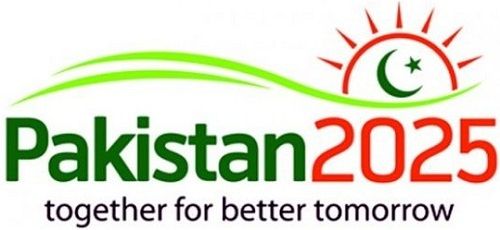PAKISTAN: VISION–2025
Pakistan’s seven pillars of Vision-2025 are based on the fact that, “All successful countries and organizations have achieved success by developing shared visions”.

The vision-2025 is based on the imperatives of embracing change and transformation, and to create new opportunities based on innate strengths of Pakistani nation.
Unfortunately, Pakistan remained a swinging pendulum between martial laws and democracy and it took sixty six years for the first democratic government to complete its tenure. According to the vision-2025, if Pakistan preserves this hard earned political stability by respecting the mandates and tenures, there is no reason why Pakistan can’t move fast on the development path because political instability and development don’t go hand in hand.
Pakistan Vision-2025 has been developed after extensive input and deliberations of all stakeholders. Prime Minister Nawaz Sharif chaired 1,000 plus stakeholder consultation conference on November 22, 2013 in Islamabad. And after extensive consultations with all stakeholders the Pakistan vision-2025 was approved by National Economic Council on May 29, 2014.
The seven pillars and the 25 goals of Pakistan Vision-2025 are:
Pillar I:
Putting People First – Developing Human and Social Capital
- Increase Primary school enrollment and completion rate to 100% & literacy rate to 90%.
- Increase Higher Education coverage from 7% to 12%, and increase number of PhD’s from 7,000 to 15,000.
- Improve Primary and Secondary Gender Parity Index to 1, and increase female workforce participation rate from 24% to 45%.
- Increase proportion of population with access to improved sanitation from 48% to 90%.
- Reduce infant mortality rate from 74 to less than 40 (per 1000 births) and reduce maternal mortality rate from 276 to less than 140 (per 1000 births).
- Reduce the incidence/prevalence of Hepatitis, Diahorrea, Diabetes and Heart Disease by 50%.
- Pakistan will be World Champions in 2 sports and win at least 25 medals in the Asian games.
Pillar II:
Achieving Sustained, Indigenous and Inclusive Growth
- Become one of the largest 25 economies in the World, leading to Upper Middle Income country status.
- Reduce poverty level by half.
- Increase annual Foreign Direct Investment from USD 600 million to over USD 15 billion.
- Increase tax to GDP ratio from 9.8% to 18%.
Pillar III:
Democratic Governance, Institutional Reform & Modernization of the Public Sector
- Place in the top 50th percentile for Political Stability (from bottom 1 percentile), No Violence/Terrorism (from bottom 1 percentile), and Control of Corruption (from bottom 13th percentile) as measured by the World Bank’s Worldwide Governance Indicators.
Pillar IV:
Energy, Water & Food Security
- Energy: double power generation to over 45,000 MW to provide uninterrupted and affordable electricity, and increase electricity access from 67% to over 90% of the population
- Energy: (a) reduce average cost per unit by over 25% by improving generation mix (15%) and reducing distribution losses (10%); (b) increase percentage of indigenous sources of power generation to over 50%; and (c) Address demand management by increasing usage of energy efficient appliances/products to 80%
- Water: increase storage capacity to 90 days, improve efficiency of usage in agriculture by 20%, and ensure access to clean drinking water for all Pakistanis
- Food: Reduce food insecure population from 60% to 30%
Pillar V:
Private Sector and Entrepreneurship Led Growth
- Rank in the top 50 countries on the World Bank’s Ease of Doing Business Rankings
- Increase Diaspora investment (via remittances) in private sector from USD 14 billion to USD 40 billion.
- Create at least 5 global Pakistani brands (having more than 50% sales coming from consumers outside Pakistan), and make ‘Made in Pakistan’ a symbol of quality
Pillar VI:
Developing a Competitive Knowledge Economy through Value Addition
- Join the ranks of the top 75 countries as measured by the World Economic Forum’s Global Competitiveness Report
- Triple labor and capital productivity
- Improve Pakistan’s score on the World Bank Institute’s Knowledge Economy Index from 2.2 to 4.0, and increase internet penetration to over 50%
- Increase the number of tourist arrivals to 2 million
Pillar VII:
Modernizing Transportation Infrastructure & Greater Regional Connectivity
- Increase road density from 32 km/100 km2 to 64 km/ 100 km2, and share of rail in transport from 4% to 20%
- Increase annual exports from US$ 25 billion to US$ 150 billion.
RELATED PAGE
— Education Vision–2025